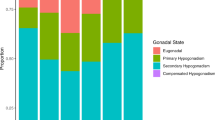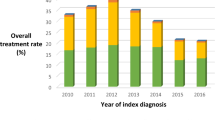Abstract
We sought to understand the relationship between hypogonadism and testosterone replacement therapy (TRT) in hypogonadal men on the risk of developing localized and metastatic prostate cancer. We used the Merative MarketScan database of commercial claims encounters to identify men diagnosed with hypogonadism. These men were matched to eugonadal men who served as controls. Multivariate negative binomial regression analysis of prostate cancer diagnoses, hypogonadism, and TRT in hypogonadal men adjusting for various known confounding factors was used to understand the impact of hypogonadism and TRT on prostate cancer risk. We identified 3,222,904 men who met inclusion criteria, of which 50% were diagnosed with hypogonadism (1,611,452) and each were matched to a control (1,611,452). The incidence of prostate cancer was 2.16%, 1.55%, and 1.99% in eugonadal controls, hypogonadal men on TRT, and hypogonadal men without TRT, respectively (p < 0.001). Untreated hypogonadism was independently associated with a decreased risk of localized prostate cancer (IRR 0.46, 95% CI 0.43–0.50, p < 0.001) compared to eugonadal controls. Hypogonadal men on TRT also had a significantly decreased risk of localized prostate cancer (IRR 0.49, 95% CI 0.45–0.53, p < 0.001). Furthermore, hypogonadal men on TRT (IRR 0.21, 95% CI 0.19–0.24, p < 0.001) or without TRT (IRR 0.20, 95% CI 0.18–0.22, p < 0.001) both had significantly decreased risk of metastatic prostate cancer, respectively. Our population-based analysis suggests that untreated hypogonadism in men is associated with a 50% decreased incidence of localized prostate cancer and an 80% decreased incidence of metastatic prostate cancer. TRT in hypogonadal men was also associated with a decreased risk of subsequent prostate cancer. Further research is needed to better understand the relationship between hypogonadism and TRT in hypogonadal men on the risk of subsequent prostate cancer.
This is a preview of subscription content, access via your institution
Access options
Subscribe to this journal
Receive 8 print issues and online access
$259.00 per year
only $32.38 per issue
Buy this article
- Purchase on Springer Link
- Instant access to full article PDF
Prices may be subject to local taxes which are calculated during checkout
Similar content being viewed by others
Data availability
MarketScan data set is available by request.
References
Khoo EM, Tan HM, Low WY. Erectile dysfunction and comorbidities in aging men: an urban cross-sectional study in Malaysia. J Sex Med. 2008;5:2925–34. https://doi.org/10.1111/j.1743-6109.2008.00988.x.
Ponholzer A, Madersbacher S, Rauchenwald M, Jungwirth S, Fischer P, Tragl KH. Vascular risk factors and their association to serum androgen levels in a population-based cohort of 75-year-old men over 5 years: results of the VITA study. World J Urol. 2010;28:209–14. https://doi.org/10.1007/s00345-009-0440-y.
Wong SY, Chan DC, Hong A, Woo J. Prevalence of and risk factors for androgen deficiency in middle-aged men in Hong Kong. Metabolism. 2006;55:1488–94. https://doi.org/10.1016/j.metabol.2006.06.019.
Mulligan T, Frick MF, Zuraw QC, Stemhagen A, McWhirter C. Prevalence of hypogonadism in males aged at least 45 years: the HIM study. Int J Clin Pract. 2006;60:762–9. https://doi.org/10.1111/j.1742-1241.2006.00992.x.
Mulhall JP, Trost LW, Brannigan RE, Kurtz EG, Redmon JB, Chiles KA, et al. Valuation and management of testosterone deficiency: AUA guideline. J Urol. 2018;200:423–32. https://doi.org/10.1016/j.juro.2018.03.115.
Anaissie J, DeLay KJ, Wang W, Hatzichristodoulou G, Hellstrom WJ. Testosterone deficiency in adults and corresponding treatment patterns across the globe. Transl Androl Urol. 2017;6:183–91. https://doi.org/10.21037/tau.2016.11.16.
Cancer statistics. Key statistics for prostate cancer. American Cancer Society. 2023.
Fendereski K, Ghaed MA, Calvert JK, Hotaling JM. Hypogonadism and urologic surgeries: a narrative review. Transl Androl Urol. 2022;11:1045–62. https://doi.org/10.21037/tau-22-308.
Hansen LG, Chang S. Health research data for the real world: The marketscan databases. Truven Health Analytics (2011).
Muller RL, Gerber L, Moreira DM, Andriole G, Castro-Santamaria R, Freedland SJ. Serum testosterone and dihydrotestosterone and prostate cancer risk in the placebo arm of the reduction by dutasteride of prostate cancer events trial. Eur Urol. 2012;62:757–64. https://doi.org/10.1016/j.eururo.2012.05.025.
Watts EL, Appleby PN, Perez-Cornago A, Bueno-de-Mesquita HB, Chan JM, Chen C, et al. Low free testosterone and prostate cancer risk: a collaborative analysis of 20 prospective studies. Eur Urol. 2018;74:585–94. https://doi.org/10.1016/j.eururo.2018.07.024.
Baillargeon J, Kuo YF, Fang X, Shahinian VB. Long-term exposure to testosterone therapy and the risk of high grade prostate cancer. J Urol. 2015;194:1612–6. https://doi.org/10.1016/j.juro.2015.05.099.
Walsh TJ, Shores MM, Krakauer CA, Forsberg CW, Fox AE, Moore KP, et al. Testosterone treatment and the risk of aggressive prostate cancer in men with low testosterone levels. PLoS ONE. 2018;13:e0199194. https://doi.org/10.1371/journal.pone.0199194.
Shabsigh R, Crawford ED, Nehra A, Slawin KM. Testosterone therapy in hypogonadal men and potential prostate cancer risk: a systematic review. Int J Impot Res. 2009;21:9–23. https://doi.org/10.1038/ijir.2008.31.
Funding
The computational resources used were partially funded by the NIH, Share Instrumentation Grant 1S10OD021644-011A1.
Author information
Authors and Affiliations
Contributions
Conceptualization, KA, JJ, MKS, JMH. Methodology, KA, JJ, MKS, JMH. Formal Analysis, JJ and ND. Writing – original draft, KA, JJ, MKS, JMH. Writing - reviewing, & editing, KA, JJ, MKS, JMH. Supervision, JMH.
Corresponding author
Ethics declarations
Competing interests
The authors declare no competing interests.
Additional information
Publisher’s note Springer Nature remains neutral with regard to jurisdictional claims in published maps and institutional affiliations.
Rights and permissions
Springer Nature or its licensor (e.g. a society or other partner) holds exclusive rights to this article under a publishing agreement with the author(s) or other rightsholder(s); author self-archiving of the accepted manuscript version of this article is solely governed by the terms of such publishing agreement and applicable law.
About this article
Cite this article
Asanad, K., Horns, J.J., Driggs, N. et al. Untreated hypogonadism and testosterone replacement therapy in hypogonadal men are associated with a decreased risk of subsequent prostate cancer: a population-based study. Int J Impot Res (2024). https://doi.org/10.1038/s41443-023-00820-3
Received:
Revised:
Accepted:
Published:
DOI: https://doi.org/10.1038/s41443-023-00820-3



